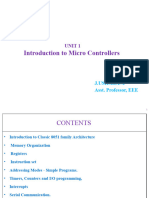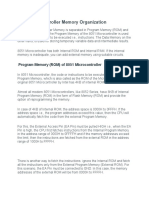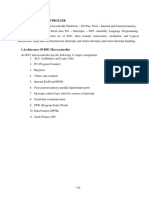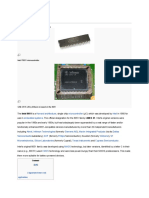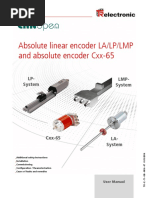8051 Microcomputer Overview: Department of EIE / Pondicherry Engineering College
8051 Microcomputer Overview: Department of EIE / Pondicherry Engineering College
Uploaded by
prof_ktCopyright:
Available Formats
8051 Microcomputer Overview: Department of EIE / Pondicherry Engineering College
8051 Microcomputer Overview: Department of EIE / Pondicherry Engineering College
Uploaded by
prof_ktOriginal Description:
Original Title
Copyright
Available Formats
Share this document
Did you find this document useful?
Is this content inappropriate?
Copyright:
Available Formats
8051 Microcomputer Overview: Department of EIE / Pondicherry Engineering College
8051 Microcomputer Overview: Department of EIE / Pondicherry Engineering College
Uploaded by
prof_ktCopyright:
Available Formats
Department of EIE / Pondicherry Engineering College
8051 Microcomputer Overview
Department of EIE / Pondicherry Engineering College
Department of EIE / Pondicherry Engineering College
8051 Microcomputer Overview
1.1 INTRODUCTION
Figure 1.1 shows a functional block of the internal operation of an 8051 microcomputer.
The internal components of the chip are shown within the broken line box.
ADDRESS BUS (External) 16 bit
Internal Memory
Internal data bus
Instruction
Register
Acc
Accumulator
Instruction
decoder/
control logic
Temporary
register
Temporary
register
PSW
flags
Control Lines
C
AC
F0
RS1
RS2
OV
P
DATA BUS (External) 8 bit
I-RAM
General Registers
STACK
Bit-addressable
SFRs etc.
P.C.
DPTR
Memory Address
Register
(Uses P0 and P2)
ALU
8-bit
RD/ WR/ PSEN/
ALE/ etc.
Figure 1.1 8051 functional block diagram.
Department of EIE / Pondicherry Engineering College
Department of EIE / Pondicherry Engineering College
Figure 1.2 shows the external code memory and data memory connected to the 8051
chip.
Note part of the external code memory can be located within the chip but we will
ignore this feature for now. Also, variants of the chip will allow a lot more memory
devices and I/O devices to be accommodate within the chip but such enhanced features
will not be considered right now.
ADDRESS BUS (16-bit)
12MHz
8051
External
DATA
Memory
(RAM)
External
CODE
Memory
(ROM)
control lines
I-RAM
DATA BUS (8-bit)
I/O ports
e.g. P1, P3 etc.
Figure 1.2 8051 chip with external memory
Department of EIE / Pondicherry Engineering College
Department of EIE / Pondicherry Engineering College
A quick comparison with the well known Pentium processor
1,000MHz
(1 GHz.)
A modern PC is powered by a Pentium processor (or equivalent), which is really a very
powerful microprocessor. Where the 8051 microcontroller represents the low end of the
market in terms of processing power, the Pentium processor is one of the most complex
processors in the world. Figure 1.3 shows a simplified block diagram of the Pentium
processor and a simple comparison between the 8051 and the Pentium is given in the
table below.
ADDRESS BUS (32-bit)
The Pentium's
Memory
Space
PENTIUM
Chip
multiple
32-bit ALUs
(Superscalar)
control lines
DATA BUS (64-bit)
Figure 1.3 Simplified diagram of a Pentium processor
Simple comparison: Pentium vs. 8051
FEATURE
8051
PENTIUM
COMMENT
Clock Speed
12Mhz. typical
but 60MHz. ICs
available
1,000 MHz. (1GHz.)
Address bus
16 bits
32 bits
Data bus
8 bits
64 bits
ALU width
8 bits
32 bits
8051 internally divides clock
by 12 so for 12MHz. clock
effective clock rate is just
1MHz.
8051 can address 216, or
64Kbytes of memory.
Pentium can address 232, or
4 GigaBytes of memory.
Pentiums wide bus allows
very fast data transfers.
But - Pentium has multiple
32 bit ALUs along with
floating-point units.
Applications
Domestic appliances,
Personal Computers
Department of EIE / Pondicherry Engineering College
Department of EIE / Pondicherry Engineering College
Power
consumption
Cost of chip
Peripherals, automotive
etc.
Small fraction of a watt
And other high
performance areas.
Tens of watts
About 2 Euros. In
volume
About 200 Euros
Depending on spec.
Department of EIE / Pondicherry Engineering College
Pentium runs hot as power
consumption increases with
frequency.
Department of EIE / Pondicherry Engineering College
The basic 8051 chip includes a number of peripheral I/O devices including two t
Timer/Counters, 8-bit I/O ports, and a UART. The inclusion of such devices on the 8051
chip is shown in figure 1.4. These I/O devices will be described later.
ADDRESS BUS (External) 16 bit
Internal Memory
DATA BUS (External) 8 bit
I-RAM
General Registers
STACK
Bit-addressable
SFRs etc.
P.C.
DPTR
Memory Address
Register
(Uses P0 and P2)
Internal data bus
Instruction
Register
Acc
Accumulator
Instruction
decoder/
control logic
Temporary
register
Temporary
register
PSW
flags
Control Lines
C
AC
F0
RS1
RS2
OV
P
Port 1
etc...
ALU
8-bit
Timer/
Counter 0
Timer/Couter
1
UART
RD/ WR/ PSEN/
ALE/ etc.
Figure 1.4 8051 showing the on-chip I/O devices
Department of EIE / Pondicherry Engineering College
Department of EIE / Pondicherry Engineering College
1.2 MEMORY AND REGISTER ORGANISATION
The 8051 has a separate memory space for code (programs) and data. We will refer here
to on-chip memory and external memory as shown in figure 1.5. In an actual
implementation the external memory may, in fact, be contained within the
microcomputer chip. However, we will use the definitions of internal and external
memory to be consistent with 8051 instructions which operate on memory. Note, the
separation of the code and data memory in the 8051 architecture is a little unusual. The
separated memory architecture is referred to as Harvard architecture whereas Von
Neumann architecture defines a system where code and data can share common memory.
FFFFh
8051 chip
Internal
Memory
External
DATA
Memory
(up to 64KB)
RAM
0000h
Internal
SFRs
FFFFh
Internal
RAM
External
CODE
Memory
(up to 64KB)
ROM
0000h
Figure 1.5 8051 Memory representation
External Code Memory
The executable program code is stored in this code memory. The code memory size is
limited to 64KBytes (in a standard 8051). The code memory is read-only in normal
operation and is programmed under special conditions e.g. it is a PROM or a Flash RAM
type of memory.
External RAM Data Memory
This is read-write memory and is available for storage of data. Up to 64KBytes of
external RAM data memory is supported (in a standard 8051).
Internal Memory
The 8051s on-chip memory consists of 256 memory bytes organised as follows:
First 128 bytes:
00h to 1Fh
20h to 2Fh
30 to 7Fh
Register Banks
Bit Addressable RAM
General Purpose RAM
Next 128 bytes:
80h to FFh
Special Function Registers
Department of EIE / Pondicherry Engineering College
Department of EIE / Pondicherry Engineering College
The first 128 bytes of internal memory is organised as shown in figure 1.6, and is referred
to as Internal RAM, or IRAM.
Byte
Address
Bit address
b7 b6 b5 b4 b3 b2 b1 b0
7Fh
General purpose
RAM area.
80 bytes
30h
2Fh
2Eh
2Dh
2Ch
2Bh
2Ah
29h
28h
27h
26h
25h
24h
23h
22h
21h
20h
1Fh
18h
17h
10h
0Fh
08h
07h
00h
7F
78
77
70
6F
68
67
60
5F
58
57
50
4F
48
47
40
3F
38
37
30
2F
28
27
20
1F
18
17
10
0F
08
07
00
Regs 0 ..7 (Bank 1)
Internal Memory
FFh
SFRs
80h
7Fh
Internal
RAM
00h
Regs 0 ..7 (Bank 1)
Register Bank 0
Regs 0 ..7 (Bank 1)
Regs 0 ..7 (Bank 0)
07h
06h
05h
04h
03h
02h
01h
00h
Reg. 7
Reg. 6
Reg. 5
Reg. 4
Reg. 3
Reg. 2
Reg. 1
Reg. 0
Figure 1.6 Organisation of Internal RAM (IRAM) memory
Register Banks: 00h to 1Fh
The 8051 uses 8 general-purpose registers R0 through R7 (R0, R1, R2, R3, R4, R5, R6,
and R7). These registers are used in instructions such as:
ADD A, R2
; adds the value contained in R2 to the accumulator
Department of EIE / Pondicherry Engineering College
Department of EIE / Pondicherry Engineering College
Note since R2 happens to be memory location 02h in the Internal RAM the following
instruction has the same effect as the above instruction.
ADD A, 02h
Now, things get more complicated when we see that there are four banks of these
general-purpose registers defined within the Internal RAM. For the moment we will
consider register bank 0 only. Register banks 1 to 3 can be ignored when writing
introductory level assembly language programs.
Bit Addressable RAM: 20h to 2Fh
The 8051 supports a special feature which allows access to bit variables. This is where
individual memory bits in Internal RAM can be set or cleared. In all there are 128 bits
numbered 00h to 7Fh. Being bit variables any one variable can have a value 0 or 1. A bit
variable can be set with a command such as SETB and cleared with a command such as
CLR. Example instructions are:
SETB 25h ; sets the bit 25h (becomes 1)
CLR 25h ; clears bit 25h (becomes 0)
Note, bit 25h is actually bit b5 of Internal RAM location 24h.
The Bit Addressable area of the RAM is just 16 bytes of Internal RAM located between
20h and 2Fh. So if a program writes a byte to location 20h, for example, it writes 8 bit
variables, bits 00h to 07h at once.
Note bit addressing can also be performed on some of the SFR registers, which will be
discussed later on.
General Purpose RAM: 30h to 7Fh
These 80 bytes of Internal RAM memory are available for general-purpose data storage.
Access to this area of memory is fast compared to access to the main memory and special
instructions with single byte operands are used. However, these 80 bytes are used by the
system stack and in practice little space is left for general storage. The general purpose
RAM can be accessed using direct or indirect addressing modes. Examples of direct
addressing:
MOV A, 6Ah ; reads contents of address 6Ah to accumulator
Examples for indirect addressing (use registers R0 or R1):
MOV R1, #6Ah
MOV A, @R1
; move immediate 6Ah to R1
; move indirect: R1 contains address of Internal RAM which
contains data that is moved to A.
Department of EIE / Pondicherry Engineering College
Department of EIE / Pondicherry Engineering College
These two instructions have the same effect as the direct instruction above.
SFR Registers
The SFR registers are located within the Internal Memory in the address range 80h to
FFh, as shown in figure 1.7. Not all locations within this range are defined. Each SFR
has a very specific function. Each SFR has an address (within the range 80h to FFh) and a
name which reflects the purpose of the SFR. Although 128 byes of the SFR address space
is defined only 21 SFR registers are defined in the standard 8051. Undefined SFR
addresses should not be accessed as this might lead to some unpredictable results. Note
some of the SFR registers are bit addressable. SFRs are accessed just like normal Internal
RAM locations.
Byte
address
Bit address
b7 b6 b5 b4 b3 b2 b1 b0
FFh
F0h
E0h
A (accumulator)
D0h
PSW
B8h
IP
B0h
Port 3 (P3)
A8h
IE
Internal Memory
FFh
SFRs
A0h
Port 2 (P2)
99h
98h
SBUF
SCON
90h
Port 1 (P1)
8Dh
8Ch
8Bh
8Ah
89h
88h
87h
TH1
TH0
TL1
TL0
TMOD
TCON
PCON
83h
82h
81h
80h
DPH
DPL
SP
Port 0 (P0)
80h
7Fh
Internal
RAM
00h
Department of EIE / Pondicherry Engineering College
10
Department of EIE / Pondicherry Engineering College
* indicates the SFR registers which are bit addressable
Figure 1.7 SFR register layout
We will discuss a few specific SFR registers here to help explain the SFR concept. Other
specific SFR will be explained later.
Port Registers SFR
The standard 8051 has four 8 bit I/O ports: P0, P1, P2 and P3.
For example Port 0 is a physical 8 bit I/O port on the 8051. Read (input) and write
(output) access to this port is done in software by accessing the SFR P0 register which is
located at address 80h. SFR P0 is also bit addressable. Each bit corresponds to a physical
I/O pin on the 8051. Example access to port 0:
SETB P0.7
CLR P0.7
; sets the MSB bit of Port 0
; clears the MSB bit of Port 0
The operand P0.7 uses the dot operator and refers to bit 7 of SFR P0. The same bit could
be addressed by accessing bit location 87h. Thus the following two instructions have the
same meaning:
CLR
CLR
P0.7
87h
PSW Program Status Word
PSW, the Program Status Word is at address D0h and is a bit-addressable register. The
status bits are listed in table 1.1.
Table 1.1. Program status word (PSW) flags
Symbol Bit
Address
Description
C (or CY)
PSW.7 D7h
Carry flag
AC
PSW.6 D6h
Auxiliary carry flag
F0
PSW.5 D5h
Flag 0
RS1
PSW.4 D4h
Register bank select 1
RS0
PSW.3 D3h
Register bank select 0
0V
PSW.2 D2h
Overflow flag
PSW.1 D1h
Reserved
P
PSW.0 D0h
Even Parity flag
Department of EIE / Pondicherry Engineering College
11
Department of EIE / Pondicherry Engineering College
Carry flag. C
This is a conventional carry, or borrow, flag used in arithmetic operations. The carry flag
is also used as the Boolean accumulator for Boolean instruction operating at the bit
level. This flag is sometimes referenced as the CY flag.
Auxiliary carry flag. AC
This is a conventional auxiliary carry (half carry) for use in BCD arithmetic.
Flag 0. F0
This is a general-purpose flag for user programming.
Register bank select 0 and register bank select 1. RS0 and RS1
These bits define the active register bank (bank 0 is the default register bank).
Overflow flag. OV
This is a conventional overflow bit for signed arithmetic to determine if the result of a
signed arithmetic operation is out of range.
Even Parity flag. P
The parity flag is the accumulator parity flag, set to a value, 1 or 0, such that the number
of 1 bits in the accumulator plus the parity bit add up to an even number.
Stack Pointer
The Stack Pointer, SP, is an 8-bit SFR register at address 81h. The small address field (8
bits) and the limited space available in the Internal RAM confines the stack size and this
is sometimes a limitation for 8051 programmes. The SP contains the address of the data
byte currently on the top of the stack. The SP pointer in initialised to a defined address. A
new data item is pushed on to the stack using a PUSH instruction which will cause the
data item to be written to address SP + 1. Typical instructions, which cause modification
to the stack are: PUSH, POP, LCALL, RET, RETI etc.. The SP SFR, on start-up, is
initialised to 07h so this means the stack will start at 08h and expand upwards in Internal
RAM. If register banks 1 to 3 are to be used the SP SFR should be initialised to start
higher up in Internal RAM. The following instruction is often used to initialise the stack:
MOV SP, #2Fh
Data Pointer
The Data Pointer, DPTR, is a special 16-bit register used to address the external code or
external data memory. Since the SFR registers are just 8-bits wide the DPTR is stored in
two SFR registers, where DPL (82h) holds the low byte of the DPTR and DPH (83h)
holds the high byte of the DPTR. For example, if you wanted to write the value 46h to
external data memory location 2500h, you might use the following instructions:
MOV
A, #46h
; Move immediate 8 bit data 46h to A (accumulator)
MOV
DPTR, #2504h
; Move immediate 16 bit address value 2504h to A.
Department of EIE / Pondicherry Engineering College
12
Department of EIE / Pondicherry Engineering College
; Now DPL holds 04h and DPH holds25h.
MOVX @DPTR, A
; Move the value in A to external RAM location 2500h.
Uses indirect addressing.
Note the MOVX (Move X) instruction is used to access external memory.
Accumulator
This is the conventional accumulator that one expects to find in any computer, which is
used to the hold result of various arithmetic and logic operations. Since the 8051
microcontroller is just an 8-bit device, the accumulator is, as expected, an 8 bit register.
The accumulator, referred to as ACC or A, is usually accessed explicitly using
instructions such as:
INC A ; Increment the accumulator
However, the accumulator is defined as an SFR register at address E0h. So the following
two instructions have the same effect:
MOV A, #52h
; Move immediate the value 52h to the accumulator
MOV E0h, #52h
; Move immediate the value 52h to Internal RAM location E0h,
which is, in fact, the accumulator SFR register.
Usually the first method, MOV A, #52h, is used as this is the most conventional (and
happens to use less space, 2 bytes as oppose to 3 bytes!)
B Register
The B register is an SFR register at addresses F0h which is bit-addressable. The B
register is used in two instructions only: i.e. MUL (multiply) and DIV (divide). The B
register can also be used as a general-purpose register.
Program Counter
The PC (Program Counter) is a 2 byte (16 bit) register which always contains the
memory address of the next instruction to be executed. When the 8051 is reset the PC is
always initialised to 0000h. If a 2 byte instruction is executed the PC is incremented by 2
and if a 3 byte instruction is executed the PC is incremented by three so as to correctly
point to the next instruction to be executed. A jump instruction (e.g. LJMP) has the effect
of causing the program to branch to a newly specified location, so the jump instruction
causes the PC contents to change to the new address value. Jump instructions cause the
program to flow in a non-sequential fashion, as will be described later.
SFR Registers for the Internal Timer
Department of EIE / Pondicherry Engineering College
13
Department of EIE / Pondicherry Engineering College
The set up and operation of the on-chip hardware timers will be described later, but the
associated registers are briefly described here:
TCON, the Timer Control register is an SFR at address 88h, which is bit-addressable.
TCON is used to configure and monitor the 8051 timers. The TCON SFR also contains
some interrupt control bits, described later.
TMOD, the Timer Mode register is an SFR at address 89h and is used to define the
operational modes for the timers, as will be described later.
TL0 (Timer 0 Low) and TH0 (Timer 0 High) are two SFR registers addressed at 8Ah and
8Bh respectively. The two registers are associated with Timer 0.
TL1 (Timer 1 Low) and TH1 (Timer 1 High) are two SFR registers addressed at 8Ch and
8Dh respectively. These two registers are associated with Timer 1.
Power Control Register
PCON (Power Control) register is an SFR at address 87h. It contains various control bits
including a control bit, which allows the 8051 to go to sleep so as to save power when
not in immediate use.
Serial Port Registers
Programming of the on-chip serial communications port will be described later in the
text. The associated SFR registers, SBUF and SCON, are briefly introduced here, as
follows:
The SCON (Serial Control) is an SFR register located at addresses 98h, and it is bitaddressable. SCON configures the behaviour of the on-chip serial port, setting up
parameters such as the baud rate of the serial port, activating send and/or receive data,
and setting up some specific control flags.
The SBUF (Serial Buffer) is an SFR register located at address 99h. SBUF is just a
single byte deep buffer used for sending and receiving data via the on-chip serial port
Interrupt Registers
Interrupts will be discussed in more detail later. The associated SFR registers are:
IE (Interrupt Enable) is an SFR register at addresses A8h and is used to enable and
disable specific interrupts. The MSB bit (bit 7) is used to disable all interrupts.
IP (Interrupt Priority) is an SFR register at addresses B8h and it is bit addressable. The IP
register specifies the relative priority (high or low priority) of each interrupt. On the
8051, an interrupt may either be of low (0) priority or high (1) priority. .
Department of EIE / Pondicherry Engineering College
14
You might also like
- Explain The Differences Between The Following: A) RISC and CISC Processors B) Harvard and Von-Neumann ArchitecturesNo ratings yetExplain The Differences Between The Following: A) RISC and CISC Processors B) Harvard and Von-Neumann Architectures45 pages
- Unit V 8051 Microcontrollers: Comparison Between Microprocessors and MicrocontrollersNo ratings yetUnit V 8051 Microcontrollers: Comparison Between Microprocessors and Microcontrollers15 pages
- Architecture of The 8051 Microcontroller: 8 - 1 5 JANUARY 2018No ratings yetArchitecture of The 8051 Microcontroller: 8 - 1 5 JANUARY 201841 pages
- Support Study Material On 8051: 1. Introduction To 8051 MicrocontrollerNo ratings yetSupport Study Material On 8051: 1. Introduction To 8051 Microcontroller38 pages
- 1 Architecture of 8051 Microcontroller PDF85% (68)1 Architecture of 8051 Microcontroller PDF18 pages
- Unit-Vi Introduction To MicrocontrollersNo ratings yetUnit-Vi Introduction To Microcontrollers13 pages
- Architecture of 8051 Microcontroller: MicrocontrollersNo ratings yetArchitecture of 8051 Microcontroller: Microcontrollers22 pages
- 8051 Microcontroller Memory OrganizationNo ratings yet8051 Microcontroller Memory Organization6 pages
- The Main Features of 8051 Microcontroller Are:: SintheNo ratings yetThe Main Features of 8051 Microcontroller Are:: Sinthe5 pages
- Microcontrollers Applications Solved Questions AnswersNo ratings yetMicrocontrollers Applications Solved Questions Answers60 pages
- Intel 8051: From Wikipedia, The Free EncyclopediaNo ratings yetIntel 8051: From Wikipedia, The Free Encyclopedia6 pages
- Intel 8051mc Architecture & Intel 8085 Microprocessor Family.No ratings yetIntel 8051mc Architecture & Intel 8085 Microprocessor Family.13 pages
- A Brief Introduction of Micro Controllers 80510% (1)A Brief Introduction of Micro Controllers 805164 pages
- Sec1601-Microprocessors and Microcontrollers-Course Material Unit IVNo ratings yetSec1601-Microprocessors and Microcontrollers-Course Material Unit IV56 pages
- Preliminary Specifications: Programmed Data Processor Model Three (PDP-3) October, 1960From EverandPreliminary Specifications: Programmed Data Processor Model Three (PDP-3) October, 1960No ratings yet
- Practical Reverse Engineering: x86, x64, ARM, Windows Kernel, Reversing Tools, and ObfuscationFrom EverandPractical Reverse Engineering: x86, x64, ARM, Windows Kernel, Reversing Tools, and ObfuscationNo ratings yet
- Engineering Exploration Camp: For School ChildrenNo ratings yetEngineering Exploration Camp: For School Children2 pages
- Revised On Flying Squad October & April - 2015 - 2016No ratings yetRevised On Flying Squad October & April - 2015 - 201634 pages
- Methodology of The Workshop: 3 (A) - Learning Scilab From Spoken TutorialsNo ratings yetMethodology of The Workshop: 3 (A) - Learning Scilab From Spoken Tutorials2 pages
- Clogo 86Irpmp1Te6 Ulyleksotel 011jefit617) 6021T0161) Olfgh 9 - 06151 Glieth Quit01161LijeuNo ratings yetClogo 86Irpmp1Te6 Ulyleksotel 011jefit617) 6021T0161) Olfgh 9 - 06151 Glieth Quit01161Lijeu2 pages
- Introduction To Microcontrollers: Department of EIE / Pondicherry Engineering College100% (1)Introduction To Microcontrollers: Department of EIE / Pondicherry Engineering College12 pages
- Addressing Modes: Department of EIE / Pondicherry Engineering CollegeNo ratings yetAddressing Modes: Department of EIE / Pondicherry Engineering College5 pages
- Absolute Linear Encoder LA/LP/LMP and Absolute Encoder Cxx-65No ratings yetAbsolute Linear Encoder LA/LP/LMP and Absolute Encoder Cxx-6568 pages
- FR05M Face Palm Fingerprint Time Attendance Access Control - HFSecurity JNo ratings yetFR05M Face Palm Fingerprint Time Attendance Access Control - HFSecurity J4 pages
- International House Network TV Instructions: RequirementsNo ratings yetInternational House Network TV Instructions: Requirements6 pages
- Installation Instructions: Revision Form ProductNo ratings yetInstallation Instructions: Revision Form Product5 pages
- Software Architecture in Practice: Ryan VazNo ratings yetSoftware Architecture in Practice: Ryan Vaz13 pages
- 10.1.3.4 Packet Tracer - Configuring OSPF Advanced FeaturesNo ratings yet10.1.3.4 Packet Tracer - Configuring OSPF Advanced Features3 pages
- KLUEG8U1EA-B0C1 M1PCA00-010 - TOSHIBA - UFS - Ver2.0 - Application - Note - Rev0.1No ratings yetKLUEG8U1EA-B0C1 M1PCA00-010 - TOSHIBA - UFS - Ver2.0 - Application - Note - Rev0.157 pages
- Introduction To Programming: UNIT 1: Basic Programming ConceptsNo ratings yetIntroduction To Programming: UNIT 1: Basic Programming Concepts25 pages
- Microsoft Active Directory Deployment Is Supported For Deployment of The Core SolidWorks Product To ClientsNo ratings yetMicrosoft Active Directory Deployment Is Supported For Deployment of The Core SolidWorks Product To Clients2 pages
- GE8151 Notes - by WWW - EasyEngineering.net 2No ratings yetGE8151 Notes - by WWW - EasyEngineering.net 2101 pages
- Partial Updates (PATCH) in Spring Boot - by Henrick Kakutalwa - The Jabberjays - MediumNo ratings yetPartial Updates (PATCH) in Spring Boot - by Henrick Kakutalwa - The Jabberjays - Medium24 pages
- A Big Data Analytics Study Challenges, Unresolved Research Issues, and Techniques100% (1)A Big Data Analytics Study Challenges, Unresolved Research Issues, and Techniques8 pages
- Advisor MASTER Total Security System: Fully IntegratedNo ratings yetAdvisor MASTER Total Security System: Fully Integrated64 pages
- Explain The Differences Between The Following: A) RISC and CISC Processors B) Harvard and Von-Neumann ArchitecturesExplain The Differences Between The Following: A) RISC and CISC Processors B) Harvard and Von-Neumann Architectures
- Unit V 8051 Microcontrollers: Comparison Between Microprocessors and MicrocontrollersUnit V 8051 Microcontrollers: Comparison Between Microprocessors and Microcontrollers
- Architecture of The 8051 Microcontroller: 8 - 1 5 JANUARY 2018Architecture of The 8051 Microcontroller: 8 - 1 5 JANUARY 2018
- Support Study Material On 8051: 1. Introduction To 8051 MicrocontrollerSupport Study Material On 8051: 1. Introduction To 8051 Microcontroller
- Architecture of 8051 Microcontroller: MicrocontrollersArchitecture of 8051 Microcontroller: Microcontrollers
- The Main Features of 8051 Microcontroller Are:: SintheThe Main Features of 8051 Microcontroller Are:: Sinthe
- Microcontrollers Applications Solved Questions AnswersMicrocontrollers Applications Solved Questions Answers
- Intel 8051mc Architecture & Intel 8085 Microprocessor Family.Intel 8051mc Architecture & Intel 8085 Microprocessor Family.
- Sec1601-Microprocessors and Microcontrollers-Course Material Unit IVSec1601-Microprocessors and Microcontrollers-Course Material Unit IV
- Preliminary Specifications: Programmed Data Processor Model Three (PDP-3) October, 1960From EverandPreliminary Specifications: Programmed Data Processor Model Three (PDP-3) October, 1960
- Practical Reverse Engineering: x86, x64, ARM, Windows Kernel, Reversing Tools, and ObfuscationFrom EverandPractical Reverse Engineering: x86, x64, ARM, Windows Kernel, Reversing Tools, and Obfuscation
- Revised On Flying Squad October & April - 2015 - 2016Revised On Flying Squad October & April - 2015 - 2016
- Methodology of The Workshop: 3 (A) - Learning Scilab From Spoken TutorialsMethodology of The Workshop: 3 (A) - Learning Scilab From Spoken Tutorials
- Clogo 86Irpmp1Te6 Ulyleksotel 011jefit617) 6021T0161) Olfgh 9 - 06151 Glieth Quit01161LijeuClogo 86Irpmp1Te6 Ulyleksotel 011jefit617) 6021T0161) Olfgh 9 - 06151 Glieth Quit01161Lijeu
- Introduction To Microcontrollers: Department of EIE / Pondicherry Engineering CollegeIntroduction To Microcontrollers: Department of EIE / Pondicherry Engineering College
- Addressing Modes: Department of EIE / Pondicherry Engineering CollegeAddressing Modes: Department of EIE / Pondicherry Engineering College
- Absolute Linear Encoder LA/LP/LMP and Absolute Encoder Cxx-65Absolute Linear Encoder LA/LP/LMP and Absolute Encoder Cxx-65
- FR05M Face Palm Fingerprint Time Attendance Access Control - HFSecurity JFR05M Face Palm Fingerprint Time Attendance Access Control - HFSecurity J
- International House Network TV Instructions: RequirementsInternational House Network TV Instructions: Requirements
- 10.1.3.4 Packet Tracer - Configuring OSPF Advanced Features10.1.3.4 Packet Tracer - Configuring OSPF Advanced Features
- KLUEG8U1EA-B0C1 M1PCA00-010 - TOSHIBA - UFS - Ver2.0 - Application - Note - Rev0.1KLUEG8U1EA-B0C1 M1PCA00-010 - TOSHIBA - UFS - Ver2.0 - Application - Note - Rev0.1
- Introduction To Programming: UNIT 1: Basic Programming ConceptsIntroduction To Programming: UNIT 1: Basic Programming Concepts
- Microsoft Active Directory Deployment Is Supported For Deployment of The Core SolidWorks Product To ClientsMicrosoft Active Directory Deployment Is Supported For Deployment of The Core SolidWorks Product To Clients
- Partial Updates (PATCH) in Spring Boot - by Henrick Kakutalwa - The Jabberjays - MediumPartial Updates (PATCH) in Spring Boot - by Henrick Kakutalwa - The Jabberjays - Medium
- A Big Data Analytics Study Challenges, Unresolved Research Issues, and TechniquesA Big Data Analytics Study Challenges, Unresolved Research Issues, and Techniques
- Advisor MASTER Total Security System: Fully IntegratedAdvisor MASTER Total Security System: Fully Integrated








